Mission San Luis
The natives of what would become the southeastern United States first
encountered the Spanish in the form of ruthless conquistadors like
Hernando de Soto in the late 1530s and early 1540s. The Spanish
founded St Augustine in
1565, and missions were extended into
what became Georgia and the Carolinas. Seeing that the Spanish
were capable of conquest, and seeing the advantages of good relations
with Spain and peace with other tribes, some tribes invited Spanish
missionaries into their communities. At the time, epidemics were
ravaging native populations, and the Christian Spanish appeared to be
immune. At the same time, neighboring tribes were always a
threat. These things were the case with
Mission San Luis, one of the missions to the Apalachee tribe in what is
now Tallahassee. For Spain, these missions not only spread the
Catholic faith, they increased Spanish influence and created client
states that served as defensive buffers. In Florida alone, the
Spanish had over 100 missions. In the case of the Apalachee,
their territory was good agricultural land, and improved techniques
along with newly arrived Spanish ranchers allowed the area to supply
food to St Augustine and Havana. Mission San Luis became Spanish
Florida's western capital. The mission developed over a number of
years, with the first friar visiting what became Tallahassee in 1608.
The Apalachee requested a permanent mission a few years later,
but the Spanish refused until about 1633. Spans soldiers first
arrived in 1638, and their presence would always be controversial, both
with the natives and the friars. In 1647 the Apalchees revolted,
in part due to forced labor requirements, but the revolt was ultimately
quashed. Some Apalachee had been concerned that all Apalachee
would be forced to convert to Christianity, and sure enough, once the
revolt was put down, everyone was forced to convert. Another
source of friction was Spanish opposition to
'the ball game', a violent sport with origins in the old religion, a
sport dedicated to the gods of rain and thunder. In 1651, the
soldiers were removed, only to return in 1654 due to the presence of
English ships nearby. Two years later the mission moved to its
final site. That same year the Apalachee were enlisted to put
down a revolt by the neighboring Timucua to the east. By 1675,
around 1,400 Apalachees lived on the site as
well as some Spanish settlers. Relations with the Apalachee were
strained between 1685 and 1687 during the two year stay of a brutal
deputy governor. Relations of the Apalachee and Spanish with the
Creeks and their English allies to the north were also strained.
In 1689, the Spanish planned a blockhouse to
defend Mission San Luis, but this was put on hold when the Spanish and
Apalachee build a fort in the Chattahoochee Valley to counter English
influence. This fort is abandoned in 1691, and in 1695
construction began on a fort at Mission San Luis. All was not
well in the missions, however, with the Spanish abusing their power,
and when the English attacked the area in 1704, Mission San Luis
was abandoned and burned just two days before the British raid arrived.
The mission system in Florida had been destroyed.
The Apalachee fled, many to the French controlled area to the
west. The area was later repopulated by other tribes.

Plaza
The mission was built on high ground overlooking a vast agricultural
area. At the center of the mission was a circular plaza
surrounded by an earthwork. Today, some of the buildings are
reconstructed with living history programs.
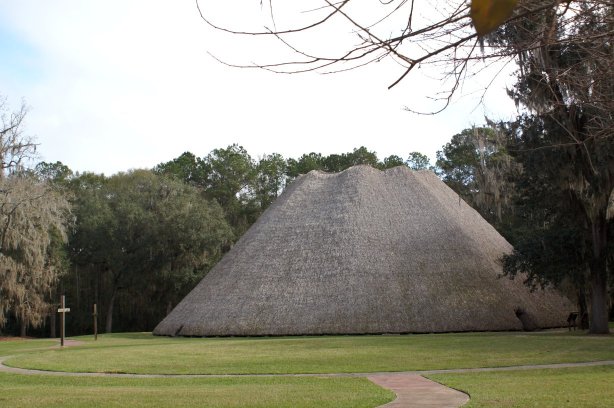

Council House
An impressive circular structure with a 120 foot diameter, the
Apalachee council house served a variety of functions - capital, hotel,
and prison to name a few. Dancing also took place - to the
displeasure of the Spanish. It was also the where cacina, a
caffinated drink, was served.
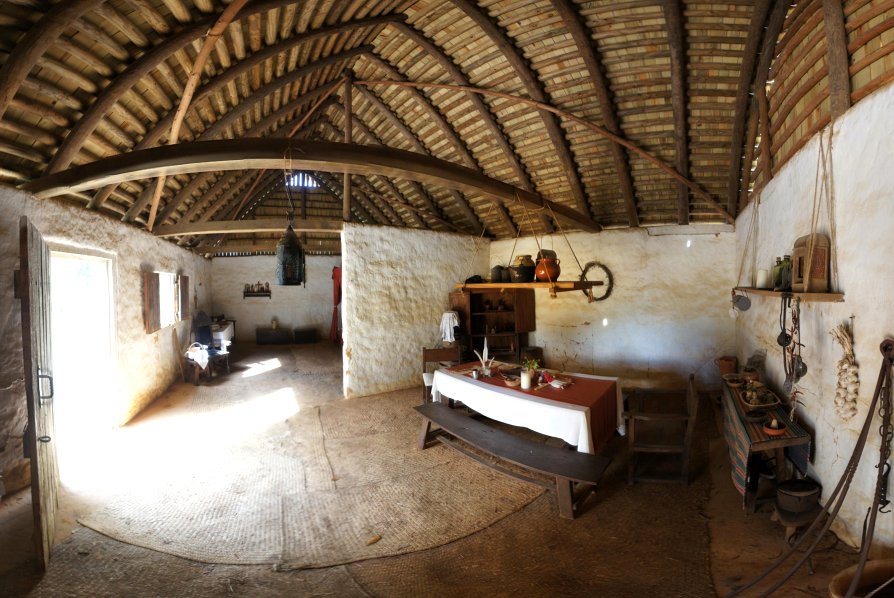
Spanish House
Spaniards coexisted with the natives. Some were merchants,
exchanging Spanish goods for things like animal hides. Spanish
arrogance and condescension could rub the Apalachee the wrong way.
In one incident, a Spanish woman failed to look after the
mentally retarded daughter of an Apalachee who was gathering nuts, and
the child drowned. As many as fifty Spanish buildings may have
existed at the mission. Buildings were not arranged in a grid
pattern, perhaps because
the mission was never designated a town, perhaps to convince the
natives that there was no plan for a town.
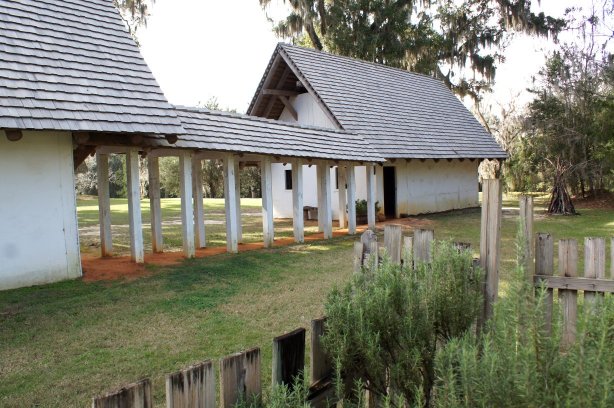
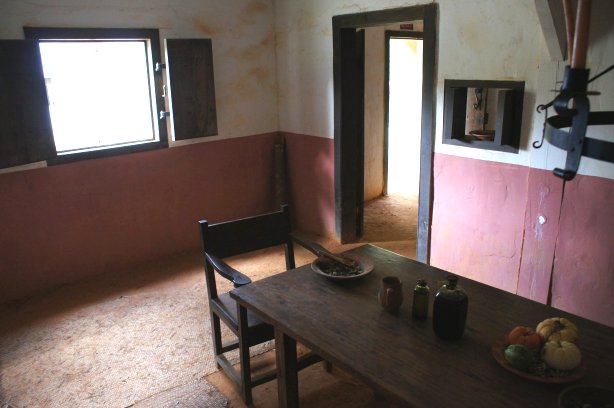
Friar's House
The friar's house was connected to the kitchen with a covered
walkway designed to be easily demolished in case of fire. The
friar was no fun at all and didn't want contact with money and women -
the finer things
in life - so his food was passed to him through a hole in the wall.
Apalachee men, on the other hand, liked contact with women, and
one
source of friction was that Christians men could no longer take
more
than one wife.
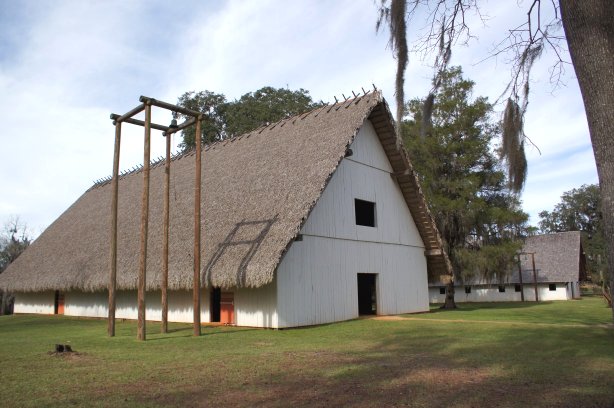

Church
The church was an impressive structure, roughly 50 by 110 feet. Natives packed in for
mass despite being unable to understand Latin. Some decorations
were imported from Spain. The reconstructed church was built to
one side of the actual site because around 800 natives were buried
beneath the church.
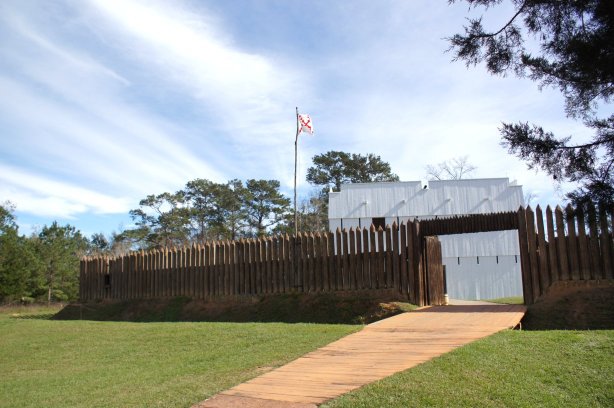
Fort
The fort consisted of a blockhouse roughly 40 by 70 feet surrounded by a four sided stockade roughly 130 by 230 feet.
Each corner except one, visible in the photo above, had a
bastion.
The number of soldiers at Mission San Luis changed over time, but
between 12 and 25 was common until the 1680s when 40 became the new
norm.
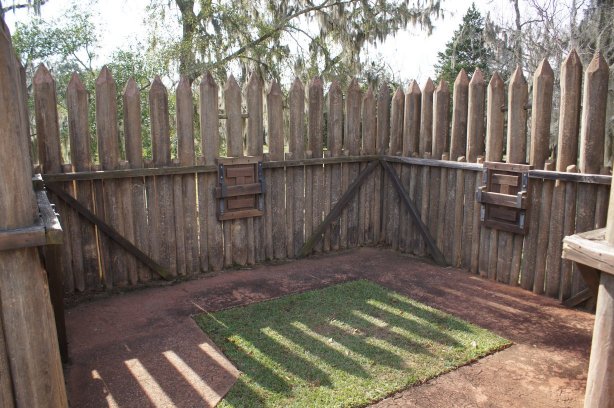
Bastion


Blockhouse
Copyright 2016 by John Hamill
Back
to John's Military History Page











